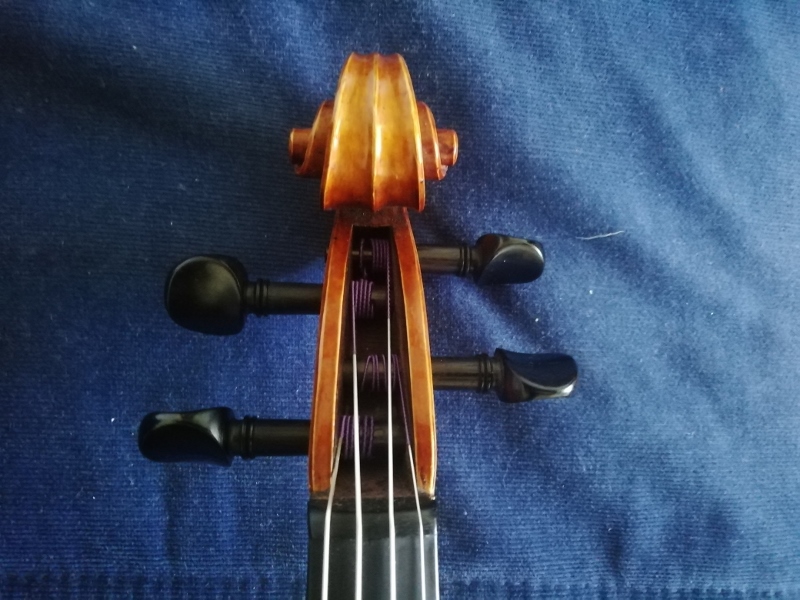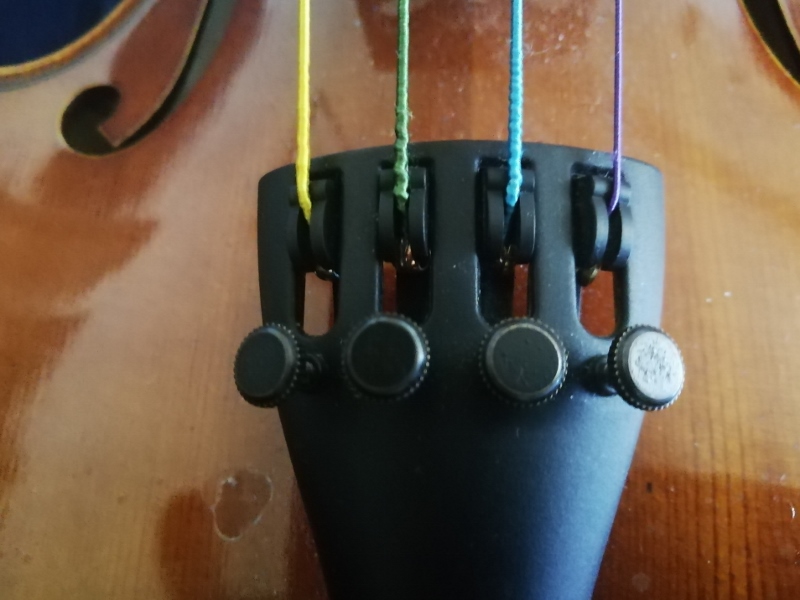The following guide is for parents and pupils who need to tune their violins and cellos. It assumes no knowledge of the instrument.
Violins and cellos go out of tune all of the time. The tuning should be checked every time you play. The method of tuning violins and cellos is broadly the same.
To tune your child’s violin you will need a tuning app on your smartphone or tablet.
Using a Tuning App
First you need to understand what is meant by sharp and flat. When we say a note is too sharp we mean it is too high – this may be represented by a sharp sign – #. Too flat means too low and may be represented by a flat sign – this looks like a squeezed b.
Usually on an tuner app there will be a scale showing “too flat” to the left and “too sharp” to the right. The note you are trying to tune to will be in the middle. The tuner will show the exact pitch of the sound as you play the string. The tuner will guess which string you are trying to tune to. If the string is very badly out of tune the tuner app may guess the string incorrectly. It is easier to tune the sound of a bowed string, but you can pluck the string too.
String Names
The violin strings are tuned to E, A, D and G. The E string is the thinnest one. It makes the highest sound.
The cello strings are tuned to A, D, G and C. The A string is the thinnest one. It makes the highest sound.
There are two ways to change pitch of a string, with the pegs and the fine tuners.
Pegs
 If the string is extremely out of tune, use the pegs at the top of the instrument (in the scroll). To turn the pegs, hold the instrument so that the strings are facing you. To tighten the string – i.e. make the sound sharper (higher) turn the peg away from you, pushing in all the time. To loosen the string – i.e. make the sound flatter (lower) turn the peg towards you, still pushing in all the time. WARNING! If you over-tighten the string you can break it. This is particularly easy to do with violin E strings. You don’t need to move the peg very much. Until you get used to it move it less than an eighth of a turn at a time, unless the string is completely loose.
If the string is extremely out of tune, use the pegs at the top of the instrument (in the scroll). To turn the pegs, hold the instrument so that the strings are facing you. To tighten the string – i.e. make the sound sharper (higher) turn the peg away from you, pushing in all the time. To loosen the string – i.e. make the sound flatter (lower) turn the peg towards you, still pushing in all the time. WARNING! If you over-tighten the string you can break it. This is particularly easy to do with violin E strings. You don’t need to move the peg very much. Until you get used to it move it less than an eighth of a turn at a time, unless the string is completely loose.
Fine Tuners
 If the string is only a little out of tune, use the fine tuners that are attached to the tailpiece at the bottom of the instrument. Turning these will make a very small adjustment to the pitch. With the strings facing you, turn clockwise to make the sound sharper (higher) or anti-clockwise to make the sound flatter (lower). It is hard to break the string by tightening it with the fine tuners unless you do a lot of turns on an already tight string. When you first use a fine tuner try turning it half a turn at a time to see what difference it makes on your tuner app.
If the string is only a little out of tune, use the fine tuners that are attached to the tailpiece at the bottom of the instrument. Turning these will make a very small adjustment to the pitch. With the strings facing you, turn clockwise to make the sound sharper (higher) or anti-clockwise to make the sound flatter (lower). It is hard to break the string by tightening it with the fine tuners unless you do a lot of turns on an already tight string. When you first use a fine tuner try turning it half a turn at a time to see what difference it makes on your tuner app.
Tuning, Step by Step
- Play each string in turn, starting with the highest. If the strings sound very odd then look at the instrument and make sure that it hasn’t had a knock. The bridge, which supports the strings, can be knocked out of place. If this happens seek help from your teacher.
- If the instrument looks OK but a string sounds very low or feels loose, start with that one. Tighten it with the peg until it is roughly in tune. Repeat until all the strings feel and sound close to normal.
- Tune the strings with the fine tuners in order. For violins start with the A string, then tune D and G before going back to the E string. For cellos, start with A then tune the D, G and C strings. If you aren’t happy using the bow, then pluck.
- Repeat number (3) until every string is correct. Remember the pegs may slip at any time and you may have to go back to number (2).